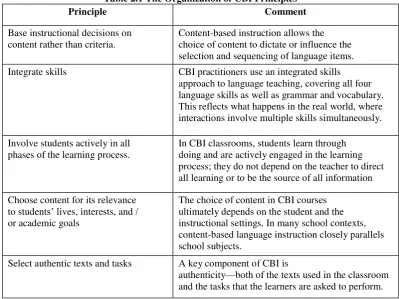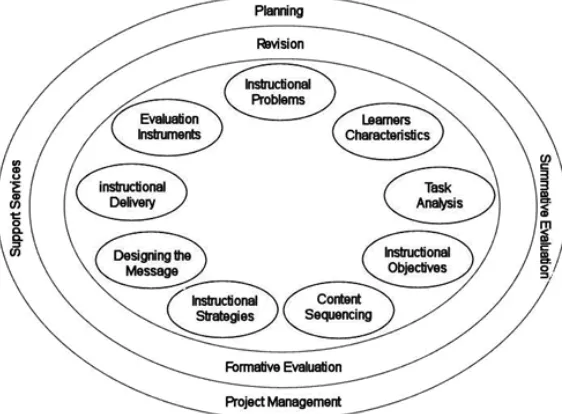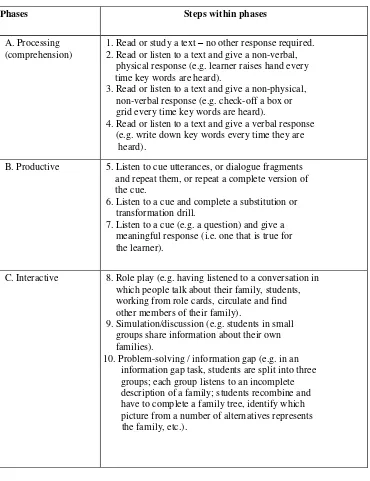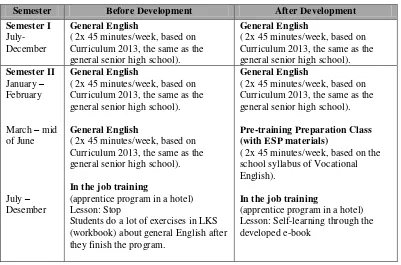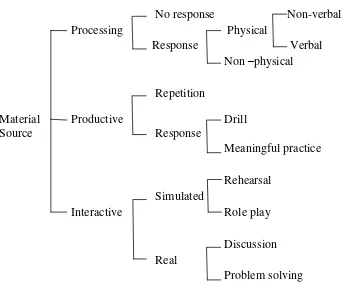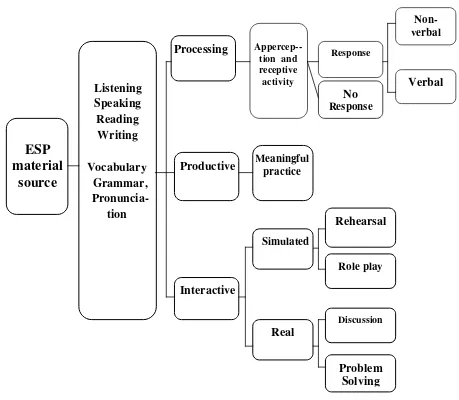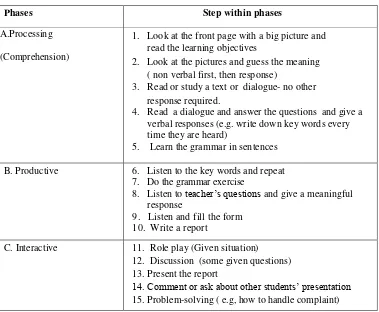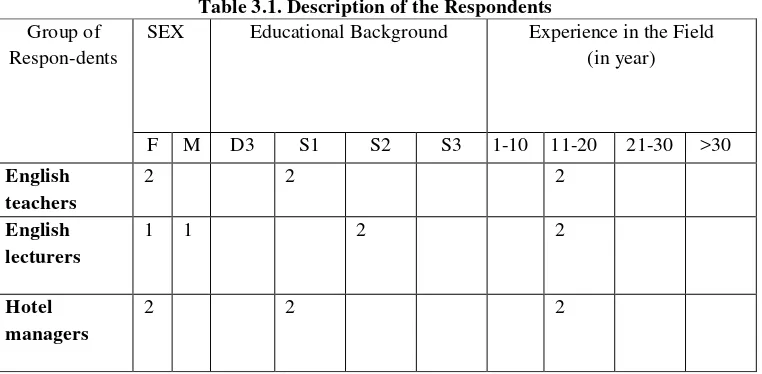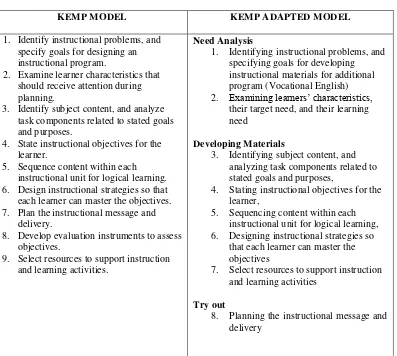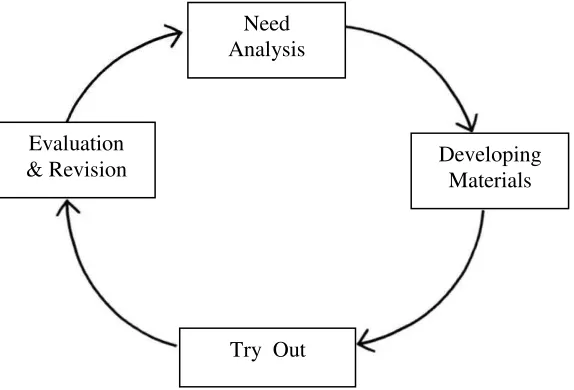ABSTRACT
By:
VALENTINA SIWI NUGROHO WIDHI
Vocational high school students, especially those of Hotel Accomodation program in SMK Negeri 1 Metro, need the skills of communicating in English to compete with academy students for better positions in the hotels. Adapting or developing an English course book for vocational high schools in Indonesia is really needed, especially for the vocational high schools applying Curriculum 2013, since they are provided with the same syllabus as that of senior high schools. The materials provided in the student book do not really help the vocational high students who will have a apprenticeship program in the first semester of their eleventh grade. With the limited time and too general materials, teachers should design supplementary ESP materials and present more effective learning instructions to trigger the students of Hotel Accommodation Program in mastering communicative English.
To overcome the problems, the Research and Development (R and D) was done to develop ESP materials in e-book format for the tenth grade students of Hotel Accommodation Program in Vocational High School. The method of the research was adapted from Kemp’s Instructional Design Model. Involving 30 students of grade 10, ten senior students in grade 11, two lecturers, two teachers, and two hotel managers, interviews and surveys were done to collect the data on students’ need and the hotel’s needs, and to get the evaluation of the materialls in the e-book format.
DEVELOPING KEMP MODEL-BASED SUPPLEMENTARY
ESP MATERIALS IN E-BOOK FORMAT FOR HOTEL
ACCOMMODATION PROGRAM STUDENTS OF
VOCATIONAL HIGH SCHOOL
(A Thesis)
By:
VALENTINA SIWI NUGROHO WIDHI
MASTER IN ENGLISH LANGUAGE TEACHING STUDY PROGRAM LANGUAGE AND ARTS EDUCATION DEPARTMENT
TEACHER TRAINING AND EDUCATION FACULTY LAMPUNG UNIVERSITY
DEVELOPING KEMP MODEL-BASED SUPPLEMENTARY
ESP MATERIALS IN E-BOOK FORMAT FOR HOTEL
ACCOMMODATION PROGRAM STUDENTS OF
VOCATIONAL HIGH SCHOOL
By:
VALENTINA SIWI NUGROHO WIDHI
A Thesis
Submitted in a partial fulfillment of the requirements for S-2 Degree
MASTER IN ENGLISH LANGUAGE TEACHING STUDY PROGRAM LANGUAGE AND ARTS EDUCATION DEPARTMENT
TEACHER TRAINING AND EDUCATION FACULTY LAMPUNG UNIVERSITY
ABSTRACT
By:
VALENTINA SIWI NUGROHO WIDHI
Vocational high school students, especially those of Hotel Accomodation program in SMK Negeri 1 Metro, need the skills of communicating in English to compete with academy students for better positions in the hotels. Adapting or developing an English course book for vocational high schools in Indonesia is really needed, especially for the vocational high schools applying Curriculum 2013, since they are provided with the same syllabus as that of senior high schools. The materials provided in the student book do not really help the vocational high students who will have a apprenticeship program in the first semester of their eleventh grade. With the limited time and too general materials, teachers should design supplementary ESP materials and present more effective learning instructions to trigger the students of Hotel Accommodation Program in mastering communicative English.
To overcome the problems, the Research and Development (R and D) was done to develop ESP materials in e-book format for the tenth grade students of Hotel Accommodation Program in Vocational High School. The method of the research was adapted from Kemp’s Instructional Design Model. Involving 30 students of grade 10, ten senior students in grade 11, two lecturers, two teachers, and two hotel managers, interviews and surveys were done to collect the data on students’ need and the hotel’s needs, and to get the evaluation of the materialls in the e-book format.
v
CURRICULUM VITAE
The writer of this thesis is Valentina Siwi Nugroho Widhi, born in Baradatu, on October 7th, 1978. Being the eldest of 4, one of whom is the only boy, she and her siblings studey at the same Elementary school; SD Bhakti Baradatu. She started her dormitory life in SMP Xaverius Metro at the age of 13. Living apart from her family in her Junior High School years, she learnt how to solve problems and to decide something by herself.
Getting the information from her seniors about a school for only girls in Yogyakarta, she then enrolled it and was accepted. The dormitory school, SMA Santa Maria Yogyakarta, offered her Language and Culture program, taking her closer to English. Joining the English club for almost three years and being one of the active contributors for the school wall magazine made her fall in love in English and education.
To reach her dream of being an English teacher, she took English Education Program at Sanata Dharma University in 1997 and graduated in 2002. She started teaching English in formal schools for her living since the third semester. Since then, she could support her study and her living by herself. The longest term of her being an English teacher was when she worked as an English teacher in her lecturer’s English course. There, she learnt a lot how to teach with love.
In 2008, she passed a very tough test to be a civil servant and taught English in a remote area; SMA Negeri 1 Pakuan Ratu, Way Kanan. In 2012, she moved to Metro, and has been teaching in SMK Negeri 1 Metro for 4 years.
viii
DEDICATION
I dedicate this thesis for my beloved ones :
My husband: Alfonsus Indra Sukma Wahyuning Baratha
My daughter: Maria Queensha Pinaring Gusti
My parents: Bapak Albert S. Suradiyanto and Ibu Sofia Susanna Sri Puryanti
My brother and sisters: Tadeus Ginanjar Sunu Jatmika, Agustina Isprapti Nur Kristanti, and Maria Dyah Kartika Laksmi Setyaningtyas
My mother and father in law: Mama R.A. Rusmijati and Papa F.X. Pudjijanto
My brothers and sister in law: Yudhatama, Baskara, and Paskalia Ayu
viii
MOTTO
If I speak in the tongues of men and of angels, but have not love, I am a noisy gong or a clanging cymbal. And if I have prophetic powers, and understand all mysteries and all knowledge, and if I have all faith, so as to remove mountains, but have not love, I am nothing. If I give away all I have, and if I deliver up my
body to be burned, but have not love, I gain nothing. (1 Corinthians 13: 1-3)
It is the supreme art of the teacher to awaken joy in creative expression and knowledge.
viii
ACKNOWLEDGEMENT
My gratefulness flies to my Allah Bapa, for my wonderful life and the lessons of love and wisdom.
I would like to show my gratitude to my first advisor, Prof. Dr. Patuan Raja, M.Pd. who inspires me so much on how he lives his life. I greatly appreciate his insightful suggestions and guidance during my thesis writing process.
I want to express my appreciation to my second advisor Dr. Flora, M.Pd., the head of Masteral Degree in English Language Teaching Study Program. I thank her so much for her patience and support in doing this research. Thank you for being a wonderful mother for all of your students.
I would like to thank my first examiner Dr. Muhammad Sukirlan, M.A. for his warm smiles, valuable suggestions, and support. I really appreciate his spending time with me talking about teaching English at school. My sincere thank also goes to the second examiner Dr. Abdurrahman, M.Si. for his detailed review and valuable inputs for my thesis.
I should also thank my respondents of my research, Yuseva Ariyani Iswandari, M.Ed., Andreas Aris Eko , M.Pd., Norma Ika damasanti, S.S., and Umi Ma’rifah, S.Pd and the students of Hotel Accommodation Program of SMK Negeri 1 Metro for their detail evaluations for my e-book, and great support for my study. My thankfulness is also sent to the principal of SMK Negeri 1 Metro, Ibu Dwi Widyaningsih, M.Pd, all teachers of SMK Negeri 1 Metro, especially my bestfriends at school; Dahrul Ahmad Ahyarudin, Nur Aminah, Suci Lestari, Sukarsih Rahayu, Zuli Astuti, and Febtry.
My special gratitude is also given to my big family of Narasumber
Nasional Guru Pembelajar, for their support and jokes. I greatly appreciate one of
viii
for your love, prayers and support.
All of my MPBI 2014 brothers and sisters, thank you so much for the love we share.
Well, may all beings be happy.
Bandar Lampung, August 15, 2016
The Researcher
CONTENT
–
2.4.2. Principles of Content – Based Instruction ... 26
2.4.3. Theory of Language in CBI ... 28
2.4.4. Theory of Learning in CBI ... 28
2.4.5. Design of Content –Based Instruction ... 29
2.5. Materials Development ... 31
2.5.1. Definition of Material Development ... 31
2.8. The Material Development in the Research ... 46
4.2.1.2. The Unit Design ... 112
4.2.2. Process ... 114
V. CONCLUSION AND SUGGESTIONS 5.1. Conclusion ... 118
5.2. Suggestions ... 120
Reference ... 121
Appendices ... 124
TABLES
Table 2.1 The Organization of CBI Principles ………..……..….. 27
Table 2.2 The Organization of Task Continuity... 40
Table 2.3 The Program Before and After Material Development...………….... 49
Table 2.4 Phases of Task Sequencing in the Developed materials ... 53
Table 3.1 Description of the Respondents...………..……….... 58
Table 4.32 The Students’ Opinion about the Developed Materials..……...……… 109
FIGURES
APPENDICES
Need Analysis Questionnaire ( tenth graders) ... 125
Developed Materials Evaluation (lecturers, teachers) ... 130
Learning Material Evaluation (tenth graders) ... 133
Content Suggestions (Eleventh graders) ... 134
List of Questions for Hotel Managers ... 135
Some Screenshots of E-book ... 136
Experts’ Review and Suggestions ... 142
Raw data of the Students’ Opinion about the Developed materials ... 150
Raw data of the Lecturers’ and Teachers’ Opinion about the Developed materials ... 151
Surat Permohonan (Expert Judgement 1) ... 154
Developed Materials Evaluation ... 155
Surat Rekomendasi Validasi 1 ... 162
Surat Permohonan (Expert Judgement 2) ... 163
Surat Rekomendasi Validasi 2 ... 164
I. INTRODUCTION
This chapter describes the background of the research which includes the reasons for conducting the research. This chapter also describes the identification of the problems, research question, objective of the research, uses of the research, scope of the research, and definition of terms.
1.1. Background
To address industrial needs and changes, the curriculum should address practical challenges and keep up with the times to strike a balance between academic requirements and industrial needs so as to cultivate professionals to the expectations of the industry concerned. Currently, owing to globalization and demands in the foreign language markets, ESP has become an important subject in institutions of higher learning. Thus, there has been the necessary need to deliver and offer information on how an ESP curriculum design can be constructed which integrates theory and industry practice that will guide students and allow them to apply and demonstrate their communication, interaction skills and social abilities via English usage in a real workplace.
they can adapt well in the real situations and work as those of professionals. The information gained from the eleventh grade students coming back from the apprentice program is that the students’ experience differs according to the nature of work and the frequency of communicating with customer. Most of them stated that they were not ready in English communication skills, especially speaking with customers or managers in English. They also mentioned their weakness in vocabulary mastery about terms in the hotel. From the informal interview with the students, they hoped that English materials about hotel could be in the school curriculum and they got more speaking skills.
Hospitality industry consists of many areas and fields. In the case of vocational students, they can be positioned at any departments in the hotel. The frequency of contact and communication with guests and customers depends on which department they are situated. Since most of the students are skilled semi-professional workers, they are better in performing tasks such as in the kitchen and housekeeping department. These students are more reserved and prefer to perform their tasks than be sociable with the guests, because they are not confident to speak in English.
qualification. With the reason, the hotels prefer to hire hotel academy students who perform better English than those of vocational high students, especially for front desk departement.
The teachers, when asked about the problem, mentioned that too general English which covers only two hours a week is not enough to facilitate the students for specific English. When the school then allocates three months before apprentice program for vocational English course, the problem of the ready-use ESP materials comes out. The teachers are not ready with the well chosen or developed materials which the students can access. The students do not get the handbook or handouts because the teachers do not provide on hand materials. The cost and the unready-use materials are the main reasons for not distributing on hand materials to the students. From the problem above, it is known that the students and the teachers of Hotel Accommodation program need supplementary ESP materials and the accessable paperless materials are considered to developed.
of methodology will be employed?’. The ‘needs analysis’ involve questions like ‘Why does the students need to learn?’, ‘Who is going to be involved in the process?’, “Where is the learning totake place’, and ‘When is the learning to take place?’. Finding the right answers to these questions results from the setting exact goals and objectives of the course. Designing a syllabus analyses what the course is going to be about and what language-learning materials support the process.
Most people associate the term ‘language-learning materials’ with coursebook. However, Tomlinson (2011:2) states that materials refer to anything which teachers or learners use to facilitate the learning of language. He adds that materials could obviously be videos, DVDs, emails, YouTube, dictionaries, grammar books, readers, workbook or photocopied exercises. Materials are the vital component concerning what happens inside the ESP classroom because they control the process of teaching and learning. In other words, materials should satisfy learners’ needs; teachers have to follow the curriculum and select the relevant materials according to them, taking into account their students’ interests and motivation. In order to help learners, the teacher may adapt, supplement, and elaborate those materials to see the learners’ purposes (El-imane, 2013:12). The
material development should be conducted when the teacher needs to provide the most suitable materials for their students.
states that ideally the two aspects of material developments mentioned above are interactive in that the theoretical studies inform and are informed by the development and use of classroom materials.
In developing the materials, the researcher considered ESP materials as the main points in her design to provide sources of language input for the vocational students. Some of authentic materials will also be considered in the developing process since they contribute to the exposure of students, especially vocational school students, to the real language used in natural, not pre-designed contexts, thus facilitating the development of their communicative competences, strategic skills and cultural knowledge. Georgieva (2012) states that although being only supplementary to the main syllabus, the usage of authentic materials is generally considered beneficial since being outside mainstream textbooks, they present an extra challenge to learners and bring about a sense of ‘realness’ to the learning
process.
To develop and elaborate relevant materials for vocational high school students, the designer or teachers should decide the instructional design model to guide the process. Many current instructional design models suggest that the most effective learning environments are those that are problem-based and involve the student in four distinct phases of learning: (1) activation of prior experience, (2) demonstration of skills, (3) application of skills, and (4) integration or these skills into real world activities (Merill, 2002:23).
inclusive (reliable) and efficient learning. The vocational school in the research is different from other schools in Metro. The decision of the school to give a vocational English as additional instructional program besides General English is very helpful to the students before working. Since the materials in this research were developed to provide additional instructional program in the school, Kemp’s model was adapted to guide the development. Kemp adopts a wide view, the oval shape of his model , which is elaborated in chapter 2, conveys that the design and development process is a continuous cycle that requires constant planning, design, development and assessment to insure effective instruction. The model is systematic and seems to encourage designers to work in all areas as appropriate. The Kemp’s instructional model defines nine different components of an
instructional design and at the same time adopts a continuous implementation/evaluation model (Morrison and Kemp, 2004:4), namely instructional problems, learners characteristics, task analysis, instructional objectives, content sequencing, instructional strategies, designing the message, instructional delivery, and evaluation instrument. This model thrives on the idea of flexibility.
The essential concept of using this model is that any of the elements can be addressed at any time in the process, giving freedom to the designer to modify their instruction as necessary, and it may start from the instructional problem, which is what happens in the researcher’s classroom. One of the major draws to
within this model, the designer have the choice to decide what elements will be needed. The lack of lines and arrows make it easier for the designer to skip around to the components she needs to address, and disregard those that she does not.
In developing the ESP materials, besides the contents, the way to deliver is one of the considerations. The growth of techology is an important thing to consider in this research. The materials developed in this research are in electronic book (e-book) format to consider the blending of technology in education. As we move further into the Digital Age, the way the students learn is changing. The students now are growing up in this technology –saturated world. The materials, mostly in a form of book, which is one of the main focal points and foundation of modern education, should adapt with the situation. As educators integrate new technologies into teaching, the book is undergoing transformation to include what is known as the electronic book, or e-book (Cavanaugh, 2006:3). As we look at the growth of technology integration into education and the need to make students resources more available, e-books provide an ideal solution. E-book may have the power to one day remove a large parts of that 20-pound book bag that students are carrying (Cavanaugh, 2006:4). The resources in e-book are easily updated and do not fill up shell space (Cavanaugh, 2006:4). The materials in the e-book can be linked to the internet, allowing the students to learn from up-to-date sources, and to get self-learning opportunities.
Hopefully, the supplementary ESP materials development addapted from Kemp’s model, designed with the content-based instructions, and delivered in the
1.2. Identification of the Problem
Adapting or developing an English course book for vocational high schools in Indonesia is really needed, especially for the vocational high schools applying Curriculum 2013, since they are provided with the same syllabus as that of senior high schools. Vocational high schools are of course different from general schools in their specialty of skills. The vocational high school students need an inserted syllabus providing English for Specific Purposes (ESP), an approach to language teaching in which all decisions depend on the vocational students’ needs. The main reason for supplying an ESP course book for the vocational high students is that because they must be ready to face the real world of professionalism. English communication skill is one of the requirements for students of Hotel Accommodation Program of Vocational High School to answer what hotels need. The service industry like hotel demands for this skill as it is extremely important for guest and work place interaction. Guests or customers are of different nationalities and English has become a standard medium for communication in a hotel. However, Curriculum 2013 sets English only for 2 x 45 minutes a week for Vocational High School students, with the same student book as Senior High School’s and with too general instruction materials. The materials provided in the
Authentic materials should be considered in the development, being close to what they really need in the real hospitality industry or bussines.
1.3. Research Question
Based on the above identification, there was a problem formulated for this research. It is:
How are Kemp model-based supplementary ESP materials in e-book format for Hotel Accommodation program sudents of Vocational High School developed?
1.4. Objectives
The objective of the research is to develop Kemp model-based supplementary ESP materials in e-book format for Hotel Accommodation program students of Vocational High School.
1.5. Uses
The research and development gives contributions to:
Theoretically: future researchers on ESP and instruction material designers with the proposed instruction development model.
1.6. Scope
The study focused on developing ESP materials for the tenth grade students of Hotel Accommodation Program of SMK Negeri 1 Metro using adapted Kemp’s model delivered in a form of electronic book (e-book) or digital book. The form of e-book was chosen to consider paperless materials and the flexibility of redesigning the materials for ongoing improvement. Some of the authentic materials in the e-book were constantly updated to meet the demand of the hotels. Besides, the e-book would be easily accessed by the students from their mobile phones and computer during their apprentice program. The developed materials then were tested and opened for other teachers to implement the materials in class to see the effectiveness and for other researchers to evaluate the developed materials.
1.7. Definition of Terms
In relation to the use of this study, there are some definitions clarified in order to have similar understanding. The terms can be described as follows:
Vocational High School
ESP
English for Specific Purposes (ESP) is an umbrella term that refers to the teaching of English to students who are learning the language for a particular work or study-related reason (Tomlinson, 2003:307 in El Imane, 2013:19).
Electronic Book (e-book)
An electronic book (also e-book, ebook, digital book) is a text- and image-basedpublication in digital form produced on, published by, and readable on computers or other digital devices (Eileen and Musto in Henry, 2010:1)
Authentic Materials
II. REVIEW OF LITERATURE
This chapter describes the concepts which are related to the research, such as concept of instructional materials, the concept of ESP materials, the concept of authentic materials, the concept of instructional development models, and the material development.
2. 1. English at Vocational High School
English is a compulsory subject in Vocational High School (Sekolah
Menengah Kejuruan). It is taught 2 x 45 minutes a week with the similar
curriculum to that of Senior High School ( Sekolah Menengah Atas). The handbooks are provided by the government for both high schools with exactly the same contents.
2.1.1 The Curriculum
The curriculum applied in most Vocational High Schools in Indonesia is Curriculum 2013. For Vocational High Schools, it is allowed to add a more needed local content lesson, as long as it is not more than 2 x 45 minutes. In 2014, SMK Negeri 1 Metro added Vocational English as a new subject
answering the students’ and business’ need for English competency, especially
English syllabus developed by the teachers. Although the syllabus was ready, the teachers had problems to get ready with the materials, so one of the teachers planned to developed a handbook for the students. However, the new policy of the Lampung governor states that Bahasa Lampung has to be in the curriculum as a compulsory subject for all levels of study, including Vocational High School. Vocational English for the tenth grade was then eliminated. To overcome the problem, the teachers managed to give an ESP lesson about three months before the students did their training or apprentice program. This research was conducted to provide the teacher and students’ needs of ESP materials.
2.1.2. Hotel Accommodation Program
Hotel Accommodation is one of the programs in Vocational High School. It focuses on three main departements; Front Office Departement (Front Desk), Food and Beverage (F&B), and Housekeeping (HK). The students of grade X usually have their training program around June or July for 6 months ahead. SMK Negeri 1 Metro has good relationships with about 7 four-to-five-star hotels in Jakarta, Yogyakarta, Bali, and Bandar Lampung. The students should show their best on a test before they are finally accepted for training. One of the tests is having a job interview in English.
functions. Therefore, ESP materials are really needed to support the students to survive in their working field.
2.2. Instructional Materials
Richards (2002:251) states that teaching materials are a key component in most language programs, and that whether the teacher uses a textbook, institutionally prepared materials, or his or her own materials, instructional materials generally serve as the basis for much of the language input learners receive and the language practice that occurs in the classroom.
2.2.1. The Role of Instructional Materials
Cunningsworth in Richards (2002:251) summarizes the role of materials (particularly coursebooks) in language teaching as:
a resource for presentation materials (spoken and written)
a source of activities for learner practice and communicative interaction
a reference source for learners on grammar, vocabulary, pronunciation, and so on a syllabus (where they reflect learning objectives that have already been determined) a support for less experienced teachers who have yet to gain in confidence.
Dudley-Evans and St. John (1998, 170-171) in Richards (2002:251-252) suggest that for teachers of ESP courses, materials serve the following functions:
as asource of language as a learning support
for motivation and stimulation for reference
and interesting content, and to provide a resource for self-study outside of the classroom.
Thus, with instructional materials, students and teachers can catch the rope to hang on together to the same direction. Students will not worry about missing the points of learning objectives, especially for having assessment, when they have the learning materials on hands.
2.2.2. Using Source Books instead of Course Books
The proper role of course books in courses is a matter of debate (Richards, 1985, Nation and Macalister, 2010:163). Prabhu (1989) in Nation and Macalister (2010:163) suggests that learners would be better served if teachers did not use course books but assembled their courses by drawing on a variety of source books such as conversation books, timed reading books, intensive reading books, listening texts, as well as teacher-made material. There are several reasons for doing this. They may be classified according to the outer circles of the curriculum design diagram ( Nation and Macalister, 2010: 163).
A single course book does not meet the diverse needs of the learners in the class. Drawing material from a variety of sources allows the teacher to keep each lesson as
close as possible to what the learners need.
Learners can have a strong say in what kind of topics and what kind of material they work with. This allows teacher and learners to negotiate the syllabus during the course. Teachers have the chance to make greater use of their professional skills, such as
material preparation, course planning, adaptation of activities, and multi-level teaching in one class.
The circumstances under which the course is taught make it difficult to find an appropriate textbook. For example, the teaching has been divided up so that one teacher deals with reading, another deals with writing and so on. Or, the class numbers are small so that learners of widely varying levels of proficiency have to be in the same class.
Current course books do not reflect ―state of the art‖ knowledge in Applied Linguistics.
coverage of the important language and skills content of the course, and to make it seem like one unified course rather than a set of unrelated bits. Such courses are often organised around themes to provide this unity. Learners sometimes complain of not seeing any obvious progress when they do not have a set course book. They further state that generally, the more trained and experienced teachers are, the more likely they are to reject the idea of a single textbook. This means that they need to be aware of the various parts of the curriculum design process and need to be able to check that the greater freedom they have to draw on a variety of types of content, presentation and assessment is matched by monitoring of all parts of the curriculum design process.
2.2.3. Adapting Existing Course Book
Nation, I.S.P and Macalister (2010:161) mention that once a course book has been chosen, teachers may wish to make substantial changes to it. They add that there are several reasons for doing this and these could be classified as responding to the environment, taking account of needs, or putting principles into practice. Some of the principles are:
The course book does not include all the activities that the teacher has used successfully before.
The course book material does not fit comfortably into the time available for the course.
The course book contains content that is unsuitable for the learners’ level
of proficiency or age.
The learners’ knowledge and skill do not match that involved in the course book.
The course book does not include language items, skills, ideas, discourse or strategies that the learners need.
The course book does not apply principles that the teacher feels should be applied.
Nation and Macalister (2010:161) explain that because of these reasons or reasons like these, the teacher may wish to adapt the course book. In this example, the teacher does not have the option of abandoning the course book, perhaps because it is the required text for the course, the learners have already bought it, or overall it has more positive features than negative features.
2.3. Instructional Materials in English for Specific Purposes (ESP) Courses Vocational high schools aim to prepare the students to compete on their work field of their expertise. The hardest challenge is to compete with academy graduates, especially in English mastery. English is one of the compulsory subjects to be taught. However, there is a difference approach to teach English in vocational high schools. Putting ESP as one of approaches is the best way to learn English based on their specific skills. Vocational high school students, especially those of Hotel service program, should learn materials designed in ESP approach to match their skills with what industry demands, besides general English. In house curriculum answering what the students and industry need should be developed as a suplementary guide.
2.3.1. The Definition of ESP
material design, pedagogy, testing and research. They added that ESP is designed to fulfill the specific needs of the learner based on needs analysis.
In conclusion, ESP is based on students’ needs in learning English. Since
students’ needs in ESP are very crucial, needs analysis should be conducted
earlier before designing the materials.
2.3.2. The Needs Analysis in ESP
Needs analysis is the very first step before designing the ESP materials. It helps the materials developer to create an appropriate materials based on the
students’ need so that it helps the students comprehending the English
materials based on their expertise. Richards (2002:52) lists a number of reasons for conducting needs analysis before starting a course for a group of learners as follows:
to find out what languages skills a learner needs in order to perform a particular role
to help determine if an existing course adequately addresses the needs of potentials students
to determine which students from a group are most in need of training in particular language skills
to identify a change of direction that people in a reference group feel is important
to identify a gap between what students are able to do and what they need to be able to do
to collect information about a particular problem learners are experiencing
knowledge and abilities the learner will require in order to be able to perform appropriately in the target situation. The analysis of the target needs is divided into three points which are necessities, lacks, and wants. They can look at
(Nation and Macalister, 2010: 24-25):
Necessities What is necessary in the learners’ use of language? For example, do learners have to write answers to exam questions?
Lacks What do learners lack? For ecxample, are there aspects of writing that were not practised in their previous learning (L1,L2)?
Wants What do the learners wish to learn?
Need analysis is really important to be conducted at the beginning before designing ESP materials since students’ learning needs are the guidance in developing appropriate English learning materials. In line with ESP approach, another approach of language teaching which is so called as Content-Based Instruction points the importance of the using of authentic materials in the classroom process.
2.3.3. Material Development in ESP
Dudley-Evans and St. John (2012:4) refer to three points: (1) ESP is designed to meet the specific needs of the learner; (2) ESP makes use of the underlying methodology and activities of the disciplines it serves; and (3) ESP is centered on the language (grammar, lexis, and register), skills, discourse and
genres appropriate to these activities. The ―absolute characteristics‖ illustrate that
an ESP approach concerns not only learners’ language issues, but also the design
of the methodology and activities related to students’ disciplines. Most
importantly, ESP views students’ needs as the first priority.
The variable characteristics are seen in five points (Dudley-Evans, 2012:5): ESP may be related to or designed for specific disciplines
ESP may use, in specific teaching situations, a different methodology from that of general English
ESP is likely to be designed for adult learners, either at a tertiary level institutio or in a professional work situation
ESP is generally designed for intermediate or advanced students
Most ESP courses assume some basic knowledge of the language system, but it can be used with beginners
2.3.4. Selecting ESP Materials
Choosing ESP materials determines the running of the course and underlines content of the lesson. Good material should help teacher in organizing the course or what is more it can function as an introduction into the new learning techniques, and support teachers and learners in the process of learning. Materials are also a kind of teacher reflection. Good material should be based on various interesting texts and activities providing a wide range of skills. Teachers determines which aspects of ESP learning will be focused on but one piece of material can serve for developing more than one skill, e.g. reading, listening, vocabulary etc. Teaching materials are tools that can be figuratively cut up into component pieces and then rearranged to suite the needs, abilities, and interests of the students in the course (Graves, 1999, in Burdova, 2007: 7). Teachers should be aware of the fact if the material is suitable not only for a particular discipline and answers given course goals but also for teachers and learners themselves. Materials should also function as a link between already learnt (´existing knowledge´) and new information (Hutchinson and Waters, 1992, Burdova, 2007: 7).
Concerning the selection of ´General English´ material and ´ESP´ material some criteria must be matched as well. Language teacher is responsible for selecting an appropriate text that contributes to students´ effectiveness that means he or she should pay attention to suitable criteria for its choice. Wallace (1992) in Burdova (2007: 10) suggests those main criteria:
Adequacy - should be at the appropriate language, age level.
Motivation - should present content which is interesting and motivating for students work. It goads into students effectiveness, interest and pleasure of work.
Diversity - should lead to a range of classroom activities, be a vehicle for teaching specific language structure and vocabulary and promote reading strategies.
Acceptability - it should accept different cultural customs or taboos.
Selecting an appropriate material regarding the main criteria is an essential phase in organizing each course. It may happen that learners´ needs and expectations are not met due to wrong choice of material. ―Materials provide a stimulus to learning. Good materials do not teach: they encourage learners to learn.― (Hutchinson and Waters, 1992, Burdova, 2007: 1,1).
2.3.5. The Role of Authentic Materials in ESP
Nunan (1999:27) in Oura (2001;67) defines authentic materials as spoken or written language data that has been produced in the course of genuine communication, and not specifically written for purposes of language teaching. In fact, in the teaching teacher may encourage his students to bring into the classroom their own samples of authentic language data from real-world contexts outside of the classroom. They practice listening to and reading genuine language drawn from many different sources, including TV and radio broadcasts, taped conversations, meetings, talks, and announcements. They also read magazine stories, hotel brochures, airport notices, bank instructions, advertisements and a wide range of other written messages from the real world in situations as they occur.
The extra time involved for teachers in planning for the use of authentic materials to supplement lessons is well worth it. In fact, using authentic materials has several advantages (Richards, 2006:20):
They provide cultural information about the target laguage. They provide exposure to real language.
They support a more creative approach to teaching.
Brosnan et al. (1984) in Oura (2001:69-70) justify the importance of the use of authentic language in the classroom in this way:
Language is natural. By simplifying language or altering it for teaching purposes (limiting structures, controlling vocabulary, etc.), we risk making the task more difficult. We may, in fact, be removing clues to meaning.
Authentic language offers students the chance to deal with a small amount of material which, at the same time, contains complete and meaningful messages.
Authentic printed materials provide students with the opportunity to make use of non-linguistic clues (layout, pictures, colors, symbols, the physical setting in which it occurs) to help them discover the meaning more easily.
While Berardo (2006:64) writes that one of the main ideas of using authentic materials in the classroom is to expose the learners to as much as real language as possible. Even if the classroom is not a real-life situation, authentic materials do have a very important place within it.
Gebhard (1996) in Oura (2001:67-68) gives more examples of authentic materials EFL- ESL teachers have used. Some of his examples, which may serve as source material for lesson planning, are shown below:
Authentic Viewing Materials -- TV commercials, quiz shows, cartoons, news clips, comedy shows, movies, soap operas, professionally audio- taped short stories and novels, radio ads, songs, documentaries, and sales pitches.
Authentic Visual Materials -- slides, photographs, paintings, children’s artwork, stick-figure drawings, wordless street signs, silhouettes, pictures from magazines, ink blots, postcard pictures, wordless picture books, stamps, and X- rays.
Authentic Printed Materials -- newspaper articles, movie advertisements, astrology columns, sports reports, obituary columns, advice columns, lyrics to songs, restaurant menus, street signs, cereal boxes, candy wrappers, tourist information brochures, university catalogs, telephone books, maps, TVguides, comic books, greeting cards, grocery coupons, pins with messages, and bus schedules.
Realia (real world objects) used in EFL- ESL Classrooms are coins and currency, folded paper, wall clocks, phones, Halloween masks, dolls, and puppets, to name a few. (Realia are often used to illustratepoints very visually or for role-play situations.)
These authentic materials should be taken from the real world and not primarily created for pedagogical reasons. Such materials are particularly important for communicative purposes since they reproduce an immersion environment and provide a realistic context for tasks that relate to learner’s needs.
2.3.6 The Role of Technology in ESP Classroom
What is now known about learning provides important guidelines for uses of technology that can help students and teachers develop the competencies needed for the twenty-first century. Tomlinson (2005:322) states that the easiest change to predict in the forseeble future for ESP materials development involve computers and technology, which will impact at least three main areas:
Subject matter. In textbooks and teacher-created materials, references to email, the internet and instant text messaging replace mention of telexes and cables. Computers can even become the focus of the study in the classromm; as more information becomes available in English on-line, learners have an increased need to learn typing and web navigating skills; the computer itself thus becomes in a way a material.
Availability of information, authentic texts and opportunities for interaction. Teachers and learners alike can access documents on-line, perhaps of particular value to those studying or teaching English as a foreign language, who might not have acess to an English language library. Learners will therefore have increasing opportunities to find their own materials, and teachers will hve greater access to authentic texts. Teachers have increased opportunities for research, whether finding the right textbook by browshing publisher’s websites, gathering information for a class reading or accessing corpora to learn about language as being used at the moment.
Ease of creating materials. As teachers have increased access to computers, they are easily able to creat the materials for classroom use. With the addition of graphics, worksheets look better and are more easily understood. When materials can be easily modified, a teacher is more likely to incorporate learners’ feedback. If both the teacher and the learners are on-line, materials can be easily sent back and forth at little or no cost.
The pictures in the materials which used to relate the clossroom to hotels were selected from the internet. The feedbacks from the students and experts were gained after they evaluated the materials in their gadgets or computers, especially to check the accessibility of the materials.
In the classroom, the developed materials were delivered using a computer and projector linked to the internet. Since the internet connection was well equipped at the school, the class was running well and the students could get the benefits without any obstacles. It proved that technology supported the ESP classroom.
2.4. Content-Based Instruction
In developing the ESP materials for hotel staff in this research, the Content-based instructions were considered very important to adjust to the needs and interests of students. Baghban and Pandian (2011) writes that another teaching/learning process corresponding to ESP and advocating the use of authentic materials is content-based instruction. Content-based instruction results in language learning, content learning, increased motivation and interest levels, and greater opportunities for employment where language abilities are necessary. The discussion about Content-based instruction was as follows:
2.4.1 Definition of Content-Based Instruction
methodology that can be described as an extention of the Communicative Language Teaching (CLT) movement but which takes different routes to achieve the goal of communicative language teaching – to develop learners’ communicative purposes (Richards 2006:27). Communication in CBI is seen as resulting from processes such as:
Interaction between the learner and users of the language Collaborative creation of meaning
Creating meaningful and purposeful interaction through language
Negotiation of meaaning as the learner and his or her interlocutor arrive at understanding
Learning through attending to the feedback learners get when they use the language
Paying attention to the language one hears (the input) and trying to incorporate new forms into one’s developing communicative competece
Trying out and experimenting with different ways of saying things.
Advocates of CBI believe that the best way to do the above processes is by using content as the driving force of classroom activities and to link all the different dimentions of communicative competence, including grammatical competence to content (Richards, 2006:27).
2.4.2. Principles of Content-Based Instruction
conjunction with a sales and marketing specialist, first identifies key topics and issues in the area of sales and marketing to rovide the framework of the course.
Brinton (2003) in Nunan (2004:132-133) sets out five principles for CBI. These are summarized in the following table.
Table 2.1 The Organization of CBI Principles
Principle Comment
Base instructional decisions on content rather than criteria.
Content-based instruction allows the choice of content to dictate or influence the selection and sequencing of language items.
Integrate skills CBI practitioners use an integrated skills
approach to language teaching, covering all four language skills as well as grammar and vocabulary. This reflects what happens in the real world, where interactions involve multiple skills simultaneously.
Involve students actively in all phases of the learning process.
In CBI classrooms, students learn through doing and are actively engaged in the learning process; they do not depend on the teacher to direct all learning or to be the source of all information
Choose content for its relevance to students’ lives, interests, and / or academic goals
The choice of content in CBI courses ultimately depends on the student and the instructional settings. In many school contexts, content-based language instruction closely parallels school subjects.
Select authentic texts and tasks A key component of CBI is
authenticity—both of the texts used in the classroom and the tasks that the learners are asked to perform.
The principles above were considered in the selection and sequencing of language items in the developed materials, and in the use an integrated skills approach to language teaching, covering all four language skills (listening, speaking, reading and writing) as well as grammar and vocabulary. This reflects what happens in the students’ future career in the hotel, where interactions involve multiple skills simultaneously.
teacher as the main source of all information. The digital form of materials allow them to learn from other sources which are more challenging and closer to what they need. By choosing content for its relevance to students’ lives, interests, and/or academic goals and also the authenticity of texts and tasks, the teacher presents meaningful information leads to deeper processing, which results in better learning. The next discussion is about the theory of language and learning and also the design in CBI which supports the process of material develoment in this research.
2.4.3 Theory of Language in CBI
A number of assumptions about the nature of language underlie Content-Based Instruction.. According to Richards and Rodgers (2001:208) the nature of language in CBI is formulated in some assumptions as follows:
Language is text- and discourse-based
The role of language in CBI is as a vehicle for learning content. The focus of the teaching English in CBI is to make students to be able to communicate and construct meaning and information through texts and discourse.
Language use draws on integrated skills
In CBI, language use involves several skills together. In a content- based class, students are usually involved in activities that use integrated skills to show how the skills usually used in the real world.
Language is purposeful
Language in CBI is used for specific purposes, but the language still gives direction, shape, and ultimately meaning to discourse and texts.
2.4.4 Theory of Learning in CBI
teaching. A number of additional assumptions that derive from the core principles of CBI is described as follows (Richards, 2006: 28):
People learn a second language most successfully when the information they are acquiring is perceived as interesting, useful, and leading to a desired goal.
Some content areas are more useful as a basis for language learning than others.
Students learn best when instruction addresses students’ needs. Teaching builds on the previous experience of the learners.
2.4.5. Design of Content-Based Instruction
The Objective of Learning
Brinton et al., in Richards and Rodgers (2014:123-124) describe that Content-Based Instructions should cover linguistics, strategic, and cultural objectives. The summaries of those objectives are to activate and develop existing English language skills, to acquire learning skills and strategies which can be applied. In addition, they state that the objectives are to:
activate and develop existing English language skills
acquire learning skills and strategies that could be applied in future language development opportunities
develop general academic skills applicable whether in university studies or all subject areas
Broaden students’ understanding of English speaking people.
The syllabus and types of activities
is built around specific topics and subtopics, as the name implies Richards and Rodgers (2001:212)
There are several types of activities which can be applied in Content-Based classroom. Stoller (1997) in Richards and Rodgers (2001:212-213) classifies those activities into five categories, which are: (i) language skills improvement, (ii) vocabulary building, (iii) discourse organization, (iv) communicative interaction, (v) study skills and synthesis of content materials and grammar.
Learner roles
Stryker and Leaver (1993:286) in Richards and Rodgers (2001:213) state that the students are the active interpreters of input. They are willing to tolerate uncertainly along the path of learning, to explore the alternative learning strategies, and to seek multiple interpretations of oral and written texts. In this approach, the learners are expected to be active interpreters of input.
Stryker and Leaver mention that learners are also expected to be source of content and joint participants in the selection of topics and activities. These learner’s role are derived from a notion proposed by Stryker and Leaver that are goal of CBI is for learners to become autonomous so that they come to understand their own learning from the very starts
Teacher roles
matter and have the ability to elicit that knowledge from the students (Stryker and Leaver, 1993) in Richards and Rodgers (2001: 214). They should also become the student needs analysts and create the learner-centered classroom (Brinton et.al., 1989) in (Richards and Rodgers, 2001:214).
The Materials
To facilitate the language learning, the materials in Content-Based Instruction are materials which are used in the subject matters of the content areas. As the central concern of Content-Based Instruction, a wide range of various materials are needed. The issue of authenticity is considered. However, the term authentic has two definitions. First, it refers to materials used by native speakers. Second, it refers to original sources such as newspaper, magazines articles, and any other media materials (Richards and Rodgers, 2001:214).
2. 5. Materials Development
2.5.1 Definition of Material Development
Developing materials for a language course or language program has some advantages compared with using the commercial course books. Richards (2001:261) coins four advantages of developing materials which are presented as follows.
Relevance
The materials will tend to be more relevant for students and institutional needs and reflect the local content, issues, and concerns.
Develop expertise
Developing materials benefit the other staffs language course to improve their expertise, giving them a greater understanding of the characteristic of effective materials.
Reputation
It will show the commitment to the language teaching because of providing relevant, specialised, and contextualised materials for the students. Flexibility
The produced materials can be revised or adapted as needed, giving them greater flexibility than a commercial course book.
Furthermore, Shulman (1987) in Richards (2001:202) cites that materials development lies at the intersection of content and pedagogy. It shows the capacity of the teachers or material developers to transform the content knowledge into pedagogical form which is relevant to the students’ needs and background.
Tomlinson (1998: 5-22; 2010:2) promoted six main principles in deeloping materials:
Expose the learners to language in authentic use
Help learners to pay attention to the features of authentic input
Provide the learners with opportunities to use the target language to achieve communicative purposes.
Provide opportunities for outcome feedback
Achieve impact in the sense that they arouse and sustain the learners’ curiousity and attention
Stimulate intellectual, aesthetic and emotional involvement
to achieve outcomes in a variety of text types and genres in relation to topics, themes, events, locations etc., likely to be meaningful to the target learners. The writer should also prioritise the potential for engagement by, for example, basing a unit on a text or a task which is likely to achieve affective and cognitive engagement rather than on a teaching point selected from a syllabus.
Tomlinson also suggested the teacher to use activities which get the learners to think about what they are reading or listening to and to respond to it personally, to use activities which get learners to think and feel before during and after using the target language for communication, and to make sure that the output activities are fully contextualised in that the learners are responding to an authentic stimulus (e.g. a text, a need, a viewpoint, an event), that they have specific addressees and that they have a clear intended outcome in mind.
2.5.2. Material Development Model
Models used for curriculum design are developed to give educators a map or guideline from which to develop curriculum or instruction for use in their field. The models are designed so that by following a process the educator can produce complete and instruction-ready material for their students on a consistent basis. There are numerous curriculum models available that are specialized to fit any given situation, but in this research the looked up to model is Kemp model.
(Kowch, 2003:1). Kemp adopts a wide view, the oval shape of his model conveys that the design and development process is a continuous cycle that requires constant planning, design, development and assessment to insure effective instruction. The model is systemic and nonlinear and seems to encourage designers to work in all areas as appropriate. The model is particularly useful for developing instructional programs that blend technology, pedagogy and content to deliver effective, inclusive (reliable) and efficient learning. Kemp identifies nine key elements:
1. Identify instructional problems, and specify goals for designing an instructional program.
2. Examine learner characteristics that should receive attention during planning.
3. Identify subject content, and analyze task components related to stated goals and purposes.
4. State instructional objectives for the learner.
5. Sequence content within each instructional unit for logical learning. 6. Design instructional strategies so that each learner can master the
objectives.
7. Plan the instructional message and delivery.
8. Develop evaluation instruments to assess objectives.
9. Select resources to support instruction and learning activities.
Identifying the need for instruction is an effort to understand a problem and to decide whether that problem can be solved through instruction. Not all performance problems indicate that people don’t know how to do their jobs; sometimes poor performance is a result of motivation, compensation, long hours, or personal circumstances. This is typically the first effort in the instructional design process. The purpose of this element is to determine the nature of the existing or potential problem and to find out whether instruction will remedy the problem.
According to Morrison, Ross, and Kemp (2004:10), a need assessment is a tool for identifying the problem and then selecting an appropriate intervention . If the problem is not clearly identified, the solution may fail to remedy the situation by attending only to the symptoms. A need is defined as the difference between the expected performance and the actual performance. When performance fails to meet expectations, there is a potential need for instruction to improve performance, identifying the problem and then selecting an appropriate intervention .
A goal analysis may be used as an alternative to a needs assessment. A goal analysis can also be used to follow-up on a needs assessment. While the needs assessment seeks to identify the various types of needs, a goal analysis begins when a need is presented. The instructional designer assumes that the need is real and proceeds to find a solution.
attitude, expectations, experience, talents, and ability to work. These characteristics may define learners who are resistant or hesitant or, conversely, learners who are highly motivated and enthusiastic. The design of the instruction
should take into consideration the learners’ readiness and willingness to learn the
material.
Instructional objectives lay out what the learner will be able to do as a result of the instruction. Objectives also indicate how the learning will be measured. Objectives help to support the instruction through three functions: (1) assist the designer in choosing activities that promote effective learning; (2) establish a foundation for evaluating learning; (3) cue the participants about what they will be learning in the unit.
Sequencing takes into consideration the nature of the content to determine the order of instruction. This method of sequencing focuses considers the content from the perspective of the learner. What does the learner need to know first? What strategies will make the learner feel at ease? Motivated? Is the learner developmentally mature enough for the content?
Kemp’s model, then was adapted in this reserach for its continuous cycle
that requires constant planning, design, development and assessment to insure effective instruction. Its systemic and nonlinear models encourages the researcher to work in all areas as appropriate. This model thrives on the idea of flexibility. In
the research, the nine steps of Kemp’s model were summarize into four basic
subject content, and analyzing task components related to stated goals and purposes, stating instructional objectives for the learner, sequencing content within each instructional unit for logical learning, dan designing instructional strategies so that each learner can master the objectives), try out (the instructional message and delivery), and Evaluation and revision (the evaluation of the developed materials from the experts and the tryout for improvement).
2.6. Unit Design Development
Commonly, there are several considerations about the task sequence, which task should come first and which the next in a unit design developmet. The following is the discussion about the principles and model of unit development, and also the task grading and sequencing.
2.6.1. Principles of Unit Development
Nunan (2004:31-33) proposes six steps of developing materials which can be used as the basis underlain the unit design development process.
1) Schema building
The first step is to develop a number of schema-building exercises that will serve to introduce the topic, set the context for the task, and introduce some of the key vocabulary and expressions that the students will need in order to complete the task.
2) Controlled practice
this would be to present learners with a brief conversation between two people discussing accommodation options relating to one of the advertisements that they studied in the previous steps:
3) Authentic listening practice
The next step involves learners in intensive listening practice. The listening texts could involve a number of native speakers inquiring about accommodation options, and the task for the learner would be to match the conversations with the advertisements from step 1. This step would expose them to authentic or simulated conversation, which could incorporate but extend the language from the model conversation in step 2.
4) Focus on linguistic elements
The exercises of this stage focus on one or more linguistic elements, such as the intonation (if the tasks are listening) or spelling, punctuation and other language mechanics if the tasks are reading or writing ones, and so on. It helps the students to see the relationship between communicative meaning and linguistic form.
5) Provide freer practice
2.6.2. Model of Unit Design forms of communication data. It provides stimulus materials for activity, new language items, correct models of language use, and a topic for communication.
2) Content focus: Language is used as a means of communication conveying information and feeling. Hence non-linguistic content can be exploited to generate meaningful communication in the classroom.
3) Language focus: Language knowledge is given in order to achieve the purpose of language learning which is enabling learners to use the language correctly.
4) Task: The communicative tasks are employed to make the learner use the content knowledge and language knowledge in the classroom.
2.6.3 Task Grading and Sequencing
amount of low- frequency vocabulary, the speed of spoken texts and the number of speakers involved, the explicitness of the information, the discourse structure and the clarity with which it is signalled. Another factor which influences the difficulty is the amount of support provided to the listener or reader. A passage with readings and subheadings which is supported with with photographs, drawings, tables, graphs, and so on should be easier to process than one in which there is no contextual support. 2) Task continuity
